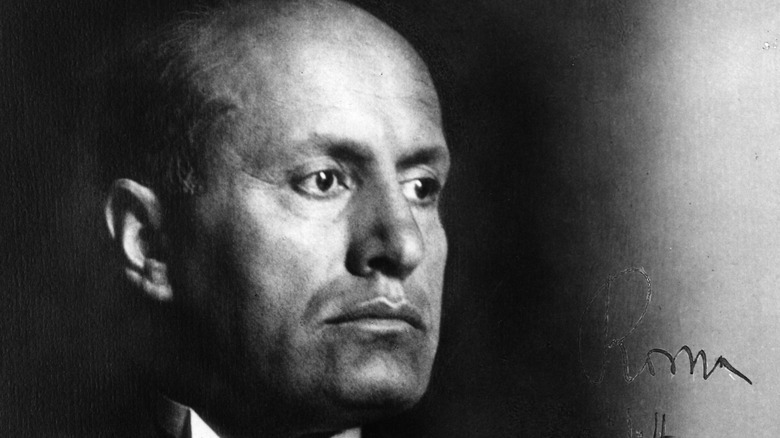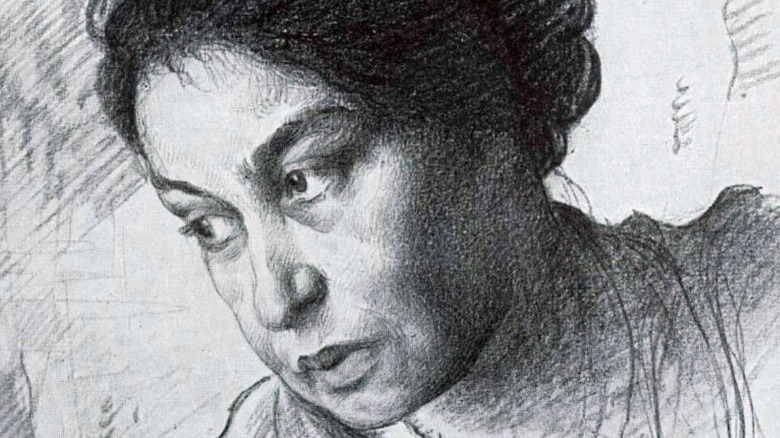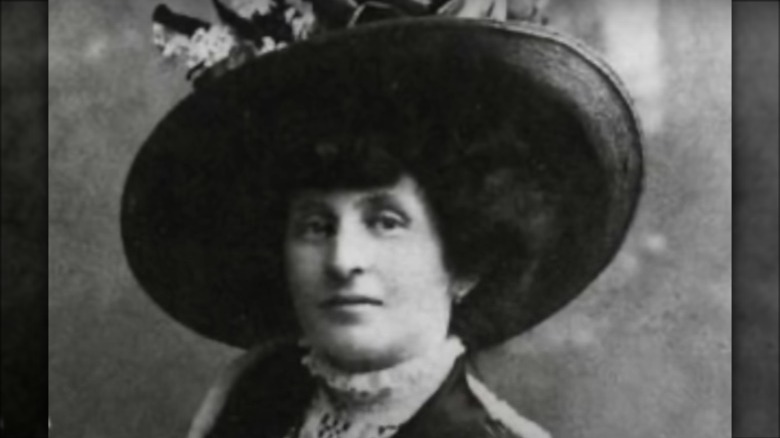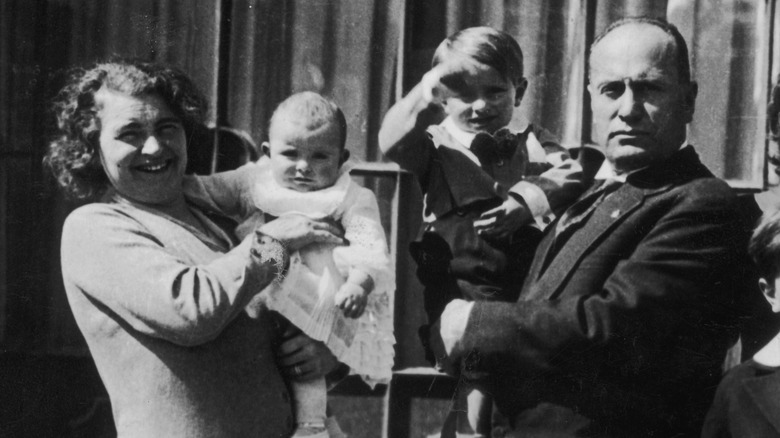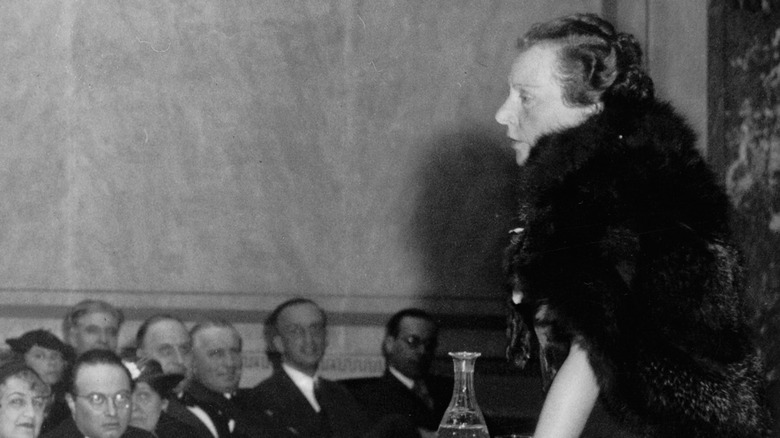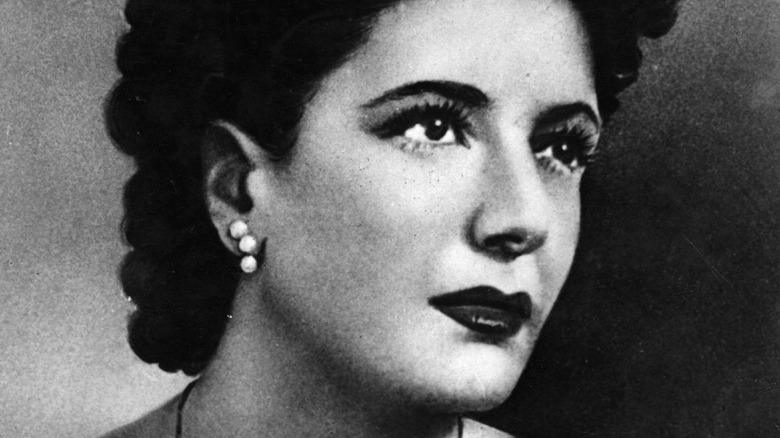The Incredible Truth About Mussolini's Love Life
Benito Mussolini, who conceived the term fascism and was the dictator of Italy from 1922 to 1943, enjoyed the image of himself as a man's man; burly and athletic, a veteran of World War I, brutal to his enemies and frank with his friends. He turned this image quite ably into propaganda to garner support for his regime. Like Vladimir Putin, the bare torso in public became one of his favorite stunts. He even went skiing shirtless.
It was a significant gesture. Mussolini had a reputation as a Don Juan, a man of innumerable conquests, as Metropolitan Magazine affirms. In an unforgettable scene in "Amarcord," Federico Fellini's 1973 reminiscent film which, according to Rotten Tomatoes, examined the impact of fascism in a small Italian town, women were depicted as worked up into a frenzy of desire at the sight of the middle-aged Il Duce (hosted on YouTube). The most incredible part about Mussolini's ability to gravitate women to him is that it seems to have been largely genuine, not manufactured. Women played a huge role in his life, from his ambitious youth to his violent death.
A lover or a friend?: Angelica Balabanoff
One of the most important women in Mussolini's early life was Angelica Balabanoff (sometimes written Balabanova). She was an unlikely grandee of the Italian Socialist Party; the party where the future right-wing strongman would make his name. In 1878, she was born in Chernihiv, Ukraine to a Jewish landowning family, making her five years older than Mussolini (per Encyclopedia). She moved to Italy in her early 20s, taking Italian citizenship and joining the Socialist Party as a propagandist. She may have felt drawn to the young, intense yet insecure Benito Mussolini, who returned to Italy after a brief and unhappy exile in Switzerland. They mirrored each other: The urbane, well-connected foreigner and the unknown rustic.
As the National News points out, we still don't know if Balabanoff and Mussolini were actually lovers, though certainly they were intimate. She groomed him for leadership, teaching him good manners and the art of intrigue that were essential in Belle Époque politics. She would eventually co-edit the Socialist newspaper "Avanti!" with Mussolini before the Socialist Party expelled him in 1914 (via Britannica).
The secret wife: Ida Dalser
It was just at this time that Mussolini met a beautician named Ida Dalser in Milan. She came from South Tyrol; a corner of Italy where German is spoken. Dalser was 34 at the time and Mussolini was 36.
The details of their courtship are obscure, but as historian Rupert Colley writes, it was quick and expedient for Mussolini. Out of work, he was trying to start a new newspaper, "Il Popolo d'Italia," to express his new explosive nationalism and irredentism. Starting a newspaper is expensive so Dalser sold her salon in order to support him. They were married in 1914 with a child born the following year. The boy was actually Mussolini's second known child.
It was not a happy marriage. Mussolini had a roaming eye, which Dalser could not have missed, and they were soon divorced. Mussolini refused to pay alimony, despite a court order or even recognize his son. Colley tells the lurid story of the abandoned Dalser, desperate for some kind of justice, later claiming to have proof that France bribed her journalist-turned-politico ex-husband to support World War I. Mussolini, by now a dictator, had her kidnapped, beaten, and sent to a mental asylum, where she died under mysterious circumstances. Their son was not informed of this when he insisted to his Navy crewmates that he was Il Duce's son, he suffered the same fate; dying while in a medically-induced coma.
The Duce's consort: Donna Rachele
She was known as "Donna Rachele." Rachele Guidi was Mussolini's "official" wife; the one who appeared in newsreels during the 20 years of his dictatorship, and the mother of all but one of his children. Of all the women in his life, her story is possibly the most bizarre.
Guidi it seems was his first love. In 1909, Mussolini returned to his native Predappio, a village near Forlì in northeast Italy. Mussolini's father Alessandro still lived there. Alessandro was a former blacksmith and Socialist Party militant. Widowed and retired, Alessandro kept a tavern, living with a woman out of wedlock who did most of the work at the tavern (per Britannica). This woman's teenage daughter was Rachele.
As Colley tells it, Mussolini actually met her in a classroom when he was working as a substitute teacher. Rachele's mother became Alessandro's mistress only after their children became a couple. Rachele inspired a ferocious passion within Mussolini. He was already married but he lived with Rachele, reportedly in squalor. During that time, the couple had a child. After he divorced, Mussolini immediately wed Rachele in a church marriage after Ida Dalser died. The couple had five children together. She didn't seem to mind his infidelities, and claimed later in her life to have had "a beautiful companion" of her own (per Colley).
His lionness: Margherita Sarfatti
In 1912, when Mussolini was three years into his relationship with Rachele Guidi, he met the art critic, novelist, and Socialist Party activist Margherita Sarfatti (née Grassini). A romantic relationship quickly followed, per the Jewish Women's Archive. By 1919, when he finally launched his Fascist Party, with Sarfatti serving as his ambassador to the world of culture.
Sarfatti belonged to an eminent Venetian family. Her father was a friend of Pope Pius X and the scientist Guiglielmo Marconi, and her cousin was the novelist Natalia Ginzburg. In her 20s, she moved to Milan to join the Socialist Party and her elegant townhouse became a salon for avant-garde artists and writers, according to the University of Chicago. As her lover's star rose, she lionized him in her essays and he rewarded her with influential editorial positions in the Fascist press. She helped craft this new ideology of violence and scorn for democracy while also convincing the government to patronize modernist artists.
Sarfatti wrote Mussolini's first biography, which won over naïve left-wing intellectuals like George Bernard Shaw, and earned her the French Legion of Honor. But things grew tense between the couple and Mussolini soon left her for a younger mistress. Worse yet, his increasing submission to Hitler made Sarfatti uneasy. Though Catholic, she was born to a Jewish family. Sarfatti fled to Argentina, only returning after the war to announce she never regretted an instant of her time with the dictator.
Till death: Clara Petacci
The lovely Clara Petacci, called Claretta, replaced Sarfatti as the married Mussolini's full-time mistress. She was almost 29 years younger than him. As Der Spiegel explains, the 19-year-old daughter of a Vatican doctor enjoyed a government chauffeur and rooms at her lover's official residence. Meanwhile, Donna Rachele and Mussolini's children lived in a modest apartment.
At the time, Mussolini had "a woman brought to him... every afternoon," according to his valet (via Der Spiegel). However, Petacci's letters show that Mussolini suffered from a rather embarrassing complaint: The inability to ultimately perform in the bedroom. Even the Queen of Italy, who tried valiantly to conquer Il Duce one evening on the beach, found him unresponsive. However, his boasts to Petacci that he'd given up a harem of 14 women to be faithful to her did not deter her. Additionally, Petacci and Mussolini were equally matched for obsessive sexual jealousy.
His growing racism certainly did not bother her. Hitler liked Petacci. Perhaps she reminded him of his own young mistress, Eva Braun, of whom Petacci would share a similar fate as. In 1945, when Mussolini tried to flee to Switzerland, he took Clara with him. They were caught and together executed via machine gun at Dongo on Lake Como. Their bodies were subsequently strung in Milan, upside down and side-by-side (per History).
